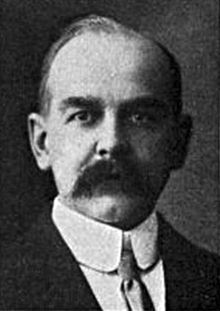George C. Whipple
| George C. Whipple | |
|---|---|

George C. Whipple, Harvard University
|
|
| Born |
March 2, 1866 New Boston, New Hampshire |
| Died | November 27, 1924 (aged 58) Cambridge, Massachusetts |
| Education | BS, Massachusetts Institute of Technology, 1889 |
| Occupation | Microbiologist and sanitary engineer |
| Known for | Cofounder of the Harvard School of Public Health |
| Awards | Water Industry Hall of Fame, American Water Works Association, 1973. |
George Chandler Whipple (March 2, 1866 – November 27, 1924) was an American civil engineer and an expert in the field of sanitary microbiology. His career extended from 1889 to 1924 and he is best known as a co-founder of the Harvard School of Public Health. Whipple published some of the most important books in the early history of public health and applied microbiology.
Whipple was born in 1866 in the small town of New Boston, New Hampshire, which is located a few miles due west of Manchester, New Hampshire. He spent most of his childhood in the Chelsea suburb of Boston where his father ran a hardware store. He graduated from the Massachusetts Institute of Technology in 1889 with a Bachelor of Science degree in civil engineering. While a student at MIT, Whipple was profoundly influenced by William T. Sedgwick. He also interacted with Dr. Thomas M. Drown and fellow students George W. Fuller and Allen Hazen. Later, Whipple undertook postgraduate work at the Stevens Institute of Technology at Hoboken, New Jersey.
His first two jobs were with water utilities: Boston Water Works as Director of the Chestnut Hill Laboratory (1889–97) and Brooklyn Department of Water Supply as Director of the Mt. Prospect Laboratory (1897-1904). While at both institutions, he gathered the material to produce his seminal work The Microscopy of Drinking Water. The book was the first text devoted exclusively to the identification and enumeration of microscopic aquatic organisms that caused problems in drinking water sources of supply. Many noteworthy items were included in the book, but two deserve special mention. First, to determine the transparency/turbidity in reservoirs, Whipple modified the original all-white Secchi disk to “…a disc about 8 inches in diameter, divided into quadrants painted alternately black and white like the target of a level-rod…” The black and white Secchi disk is the standard disk currently used in limnology investigations and marine water quality studies. Second, Chapter 9 of his book organized for the first time what was known about odors in water supplies and how algae and other microorganisms contributed to problem odors.
...
Wikipedia
